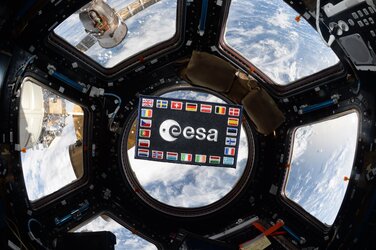Accept all cookies Accept only essential cookies See our Cookie Notice

About ESA
The European Space Agency (ESA) is Europe’s gateway to space. Its mission is to shape the development of Europe’s space capability and ensure that investment in space continues to deliver benefits to the citizens of Europe and the world.
Highlights
ESA - United space in Europe
This is ESA ESA facts Member States & Cooperating States Funding Director General Top management For Member State Delegations European vision European Space Policy ESA & EU Space Councils Responsibility & Sustainability Annual Report Calendar of meetings Corporate newsEstablishments & sites
ESA Headquarters ESA ESTEC ESA ESOC ESA ESRIN ESA EAC ESA ESAC Europe's Spaceport ESA ESEC ESA ECSAT Brussels Office Washington OfficeWorking with ESA
Business with ESA ESA Commercialisation Gateway Law at ESA Careers Cyber resilience at ESA IT at ESA Newsroom Partnerships Merchandising Licence Education Open Space Innovation Platform Integrity and Reporting Administrative Tribunal Health and SafetyMore about ESA
History ESA Historical Archives Exhibitions Publications Art & Culture ESA Merchandise Kids Diversity ESA Brand Centre ESA ChampionsLatest
Space in Member States
Find out more about space activities in our 23 Member States, and understand how ESA works together with their national agencies, institutions and organisations.
Science & Exploration
Exploring our Solar System and unlocking the secrets of the Universe
Go to topicAstronauts
Missions
Juice Euclid Webb Solar Orbiter BepiColombo Gaia ExoMars Cheops Exoplanet missions More missionsActivities
International Space Station Orion service module Gateway Concordia Caves & Pangaea BenefitsLatest
Space Safety
Protecting life and infrastructure on Earth and in orbit
Go to topicAsteroids
Asteroids and Planetary Defence Asteroid danger explained Flyeye telescope: asteroid detection Hera mission: asteroid deflection Near-Earth Object Coordination CentreSpace junk
About space debris Space debris by the numbers Space Environment Report In space refuelling, refurbishing and removingSafety from space
Clean Space ecodesign Zero Debris Technologies Space for Earth Supporting Sustainable DevelopmentLatest
Applications
Using space to benefit citizens and meet future challenges on Earth
Go to topicObserving the Earth
Observing the Earth Future EO Copernicus Meteorology Space for our climate Satellite missionsCommercialisation
ESA Commercialisation Gateway Open Space Innovation Platform Business Incubation ESA Space SolutionsLatest
Enabling & Support
Making space accessible and developing the technologies for the future
Go to topicBuilding missions
Space Engineering and Technology Test centre Laboratories Concurrent Design Facility Preparing for the future Shaping the Future Discovery and Preparation Advanced Concepts TeamSpace transportation
Space Transportation Ariane Vega Space Rider Future space transportation Boost! Europe's Spaceport Launches from Europe's Spaceport from 2012Latest

STS-128 patch, 2009
Thank you for liking
You have already liked this page, you can only like it once!
ESA astronaut Christer Fuglesang (SE) flew on the Space Shuttle Discovery STS-128 mission to the ISS in August 2009, spending nearly 14 days in space. He was accompanied by NASA astronauts Frederick Sturckow, Kevin Ford, Patrick Forrester, José Hernández, John Olivas and Nicole Stott.
STS-128 (ISS assembly flight 17A) carried the Multipurpose Logistics Module 'Leonardo' as the primary payload. Three spacewalks were carried out during the mission, which removed and replaced a materials processing experiment outside ESA's Columbus laboratory and returned an empty ammonia tank assembly.
The STS-128 patch was designed by STS-128 Mission Specialist Pat Forrester. He chose an oval-shape wrapped in ribbons that depicted Discovery carrying the 'Leonardo' module. Bathed in blue and yellow, the emblem seemed to also mimic the colours of the Swedish flag. "It wasn't until later on that we kind of looked at it and said 'wow there are a lot of similarities' with these colours," recalled Forrester. "I was just looking for more blues, a lot of the [past] patches weren't blue."
Also on the patch, Earth and the ISS wrap around the NASA Astronaut symbol reminding us of the continuous human presence in space. On the original artwork, the graphic of the ISS had missed off ESA's Columbus laboratory, and those first patches have since became rare collector's items. It was not Forrester's original intention to depict a specific space station configuration when he sketched the concept for the patch, so the station design was selected from art already created.
"By the time we launched, we were on our fourth mission patch because the names changed," Forrester described. "I think the [Astronaut] Office realised that we can't keep printing a thousand patches and then change them three times during the training flow."
The astronauts received the Columbus-amended patches a few weeks before the launch. "I believe that all the patches we will be wearing will have Columbus!" Forrester said.
-
CREDIT
NASA -
LICENCE
ESA Standard Licence

ESA ISS Mission Patches

Forrester and Fuglesang wait to enter Discovery for…

ESA astronaut patch in space

STS-122 mission patch















 Germany
Germany
 Austria
Austria
 Belgium
Belgium
 Denmark
Denmark
 Spain
Spain
 Estonia
Estonia
 Finland
Finland
 France
France
 Greece
Greece
 Hungary
Hungary
 Ireland
Ireland
 Italy
Italy
 Luxembourg
Luxembourg
 Norway
Norway
 The Netherlands
The Netherlands
 Poland
Poland
 Portugal
Portugal
 Czechia
Czechia
 Romania
Romania
 United Kingdom
United Kingdom
 Slovenia
Slovenia
 Sweden
Sweden
 Switzerland
Switzerland
























